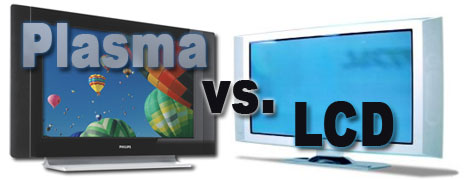Choosing a display that is right for you.
High-definition television (HDTV) means broadcast of television signals with a higher resolution than traditional formats (NTSC, SECAM, PAL) allow. Except for an early analog format in Japan, HDTV is broadcast digitally, and therefore its introduction sometimes coincides with the introduction of digital television (DTV).
Historically, the term high-definition television was also used to refer to television standards developed in the 1930s to replace the early experimental systems.
For more information on HDTV, see the Wikipedia article here
Plasma vs. LCD
 Choosing between a Plasma or LCD television can be a complicated decision. However, the complexity is usually because of the lack of knowledge on the two similar, yet competing, products. Both Plasma and LCD’s come in similar packages, but differ as to how they process and display light signals. They create images differently. It is up to the individual buyer as to which product best suits their needs.Plasmas have a wider viewing angle than many other televisions, which means you don’t have to sit in the “sweet spot” in the living room to get a good view of the TV. The larger size plasma televisions provide the most dramatic difference when viewing HDTV.Contrast & Color SaturationPlasma TVs offer better contrast and color saturation than LCD’s by design. As a result, LCDs black isn’t quite as black (contrast) as with a plasma TV and stray light tends to dilute color (color saturation).Burn-in Choosing between a Plasma or LCD television can be a complicated decision. However, the complexity is usually because of the lack of knowledge on the two similar, yet competing, products. Both Plasma and LCD’s come in similar packages, but differ as to how they process and display light signals. They create images differently. It is up to the individual buyer as to which product best suits their needs.Plasmas have a wider viewing angle than many other televisions, which means you don’t have to sit in the “sweet spot” in the living room to get a good view of the TV. The larger size plasma televisions provide the most dramatic difference when viewing HDTV.Contrast & Color SaturationPlasma TVs offer better contrast and color saturation than LCD’s by design. As a result, LCDs black isn’t quite as black (contrast) as with a plasma TV and stray light tends to dilute color (color saturation).Burn-inWhen watching TV programs on plasma with bright logos in the bottom right corner, or when playing computer games that have static image, the image can burn-in on the screen. When you watch something else, you can still see a faint image of the logo or game console. Sometimes this can be remedied by viewing video noise (snow) on a channel without any programming, but still can be a problem. If you’re a big gamer, consider LCD instead of plasma. Size and Cost Viewing Angle |


